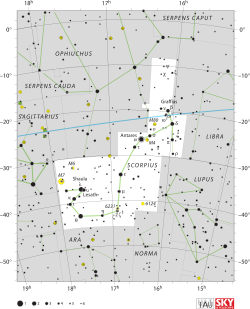Sigma Scorpii
| Observation data Epoch J2000.0 Equinox J2000.0 |
|
|---|---|
| Constellation | Scorpius |
| Right ascension | 16h 21m 11.31571s |
| Declination | –25° 35′ 34.0515″ |
| Apparent magnitude (V) | +2.88 |
| Characteristics | |
| Spectral type | B1 III + B1 V |
| U−B color index | –0.70 |
| B−V color index | +0.13 |
| Astrometry | |
| Radial velocity (Rv) | –0.4 km/s |
| Proper motion (μ) |
RA: –10.60 mas/yr Dec.: –16.28 mas/yr |
| Distance |
568+75 −59 ly (174+23 −18pc) |
| Absolute magnitude (MV) | −4.12±0.34 / −3.32±0.34 |
| Orbit | |
| Primary | σ Sco A |
| Companion | σ Sco B |
| Period (P) | 33.010±0.002 days |
| Semi-major axis (a) | 3.62±0.06 mas |
| Eccentricity (e) | 0.3220±0.0012 |
| Inclination (i) | 158.2±2.3° |
| Longitude of the node (Ω) | 104±5° |
| Periastron epoch (T) | 34889.0±1.0 MJD |
|
Argument of periastron (ω) (secondary) |
283±5° |
| Details | |
| σ Sco A | |
| Mass | 18.4±5.4,17.2-18.0 M☉ |
| Radius | 12.7±1.8 R☉ |
| Luminosity | (2.9±0.8)×104,95500 L☉ |
| Surface gravity (log g) | 3.85 cgs |
| Temperature | 26150±1070,27700 K |
| Metallicity [Fe/H] | −0.20±0.20 dex |
| Rotational velocity (v sin i) | 25 km/s |
| Age | 8.0±0.2,8-10 Myr |
| σ Sco B | |
| Mass | 11.9±3.1 M☉ |
| Radius | 11 R☉ |
| Luminosity | (1.6±0.4)×104 L☉ |
| Other designations | |
| Database references | |
| SIMBAD | data |
Sigma Scorpii (σ Sco, σ Scorpii), also named Alniyat, is a star system in the constellation Scorpius. This system has a combined apparent visual magnitude of +2.88, making it one of the brighter members of the constellation, although greatly outshone by its neighbor Antares. Based upon parallax measurements made during the Hipparcos mission, the distance to Sigma Scorpii is roughly 696 light years (214 parsecs). North et al. (2007) computed a more accurate estimate of 568+75
−59 light years (174+23
−18 parsecs).
The brightest component of the system is a double-lined spectroscopic binary, which means that the pair has not been resolved using a telescope. Instead, their orbit is determined by changes in their combined spectrum caused by the Doppler shift. This indicates that the pair complete an orbit every 33.01 days and have an orbital eccentricity of 0.32.
The primary component of the spectroscopic binary, σ Scorpii A, is an evolved giant star with a stellar classification of B1 III. It has around 18 times the mass of the Sun and 12 times the Sun's radius. This star is radiating about 29000 times the luminosity of the Sun from its outer envelope at an effective temperature of 26150 K. This is a variable star of the Beta Cephei type, causing the apparent magnitude to vary between +2.86 and +2.94 with multiple periods of 0.2468429, 0.239671, and 8.2 days. During each pulsation cycle, the temperature of the star varies by 4000±2000 K.
...
Wikipedia

